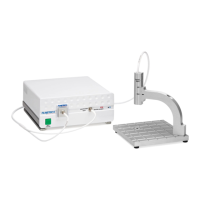The amplitude of the oscillations is determined by the refractive index and extinction coefficient of
the films and substrate. Therefore, by analyzing the period and amplitude of these oscillations, our
instruments can determine thickness of multiple thin-films.
Thickness Measurement Details
Optical thin-film thickness measurements require the successful completion of two tasks: acqui-
sition and then analysis of an accurate reflectance spectrum. To determine film thickness, FILM-
easure calculates a reflectance spectrum that matches as closely as possible the measured spectrum.
FILMeasure begins with an initial guess for what the reflectance spectrum should look like theo-
retically, based on the user’s input of a film structure for the sample. Then FILMeasure varies the
parameters it is solving for until the calculated reflectance spectrum matches the measured data.
Mathematically, this procedure is complicated by the fact that as the thickness of the films in the cal-
culation is varied there can be many near matches. Therefore, an approach that simply homes in on
a solution by finding successively better approximations will not work unless the starting guess for
optical thickness is within approximately 1000 Å if the actual thickness.
FILMeasure avoids homing in on a false solution by searching the entire acceptable thickness
range to determine the thickness that gives the best possible match between the measured and cal-
culated spectra. The thickness range searched is determined by the initial guess for thickness
together with the thickness constraint. Since the time to find a solution is proportional to the range
of thicknesses being searched it is beneficial to provide an initial guess for the thickness of the films
to be measured.
F20 Hardware Operation
The F20 performs two distinct functions: data acquisition and data analysis. Data analysis specifics
are discussed in Software Overview. In this section we describe how the F20 acquires accurate
spectral reflectance data.
Light is supplied by a tungsten-halogen bulb that generates light from approximately 375 nm to
3000 nm. This light is delivered to and collected from the sample through a fiber-optic cable bun-
dle and a lens. The intensity of the reflected light is measured at different wavelengths with a spec-
trometer. The F20 spectrometer uses a diffraction grating to disperse the light and a linear
photodiode array to measure the light at the different wavelengths. After a user-selectable inte-
gration time, the accumulated charge in each photodiode is read by the computer. Because a longer
integration time results in a larger charge, it is the integration time that determines the sensitivity of
the spectrometer. Adjustment of the integration time is used to obtain the proper signal level. Too
short an integration time results in a weak, noisy signal, while too long of an integration time
results in a saturated signal.

